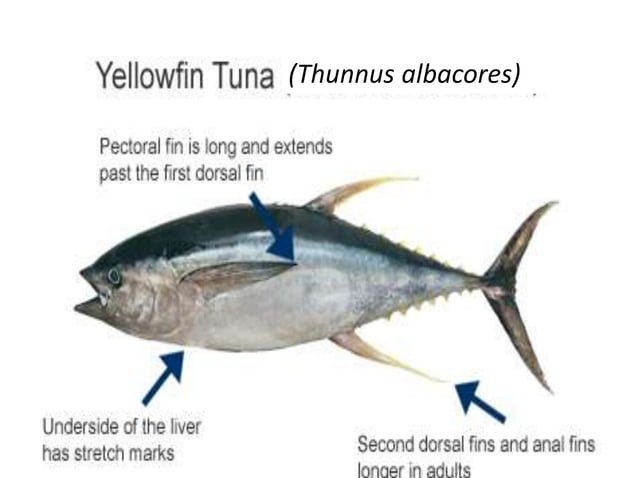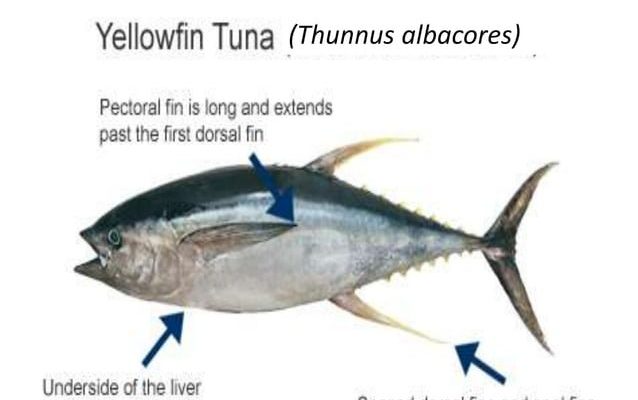
Imagine sitting in a bustling restaurant by the ocean, where the menu features an array of mouthwatering options. The yellowfin tuna approaches a bounty of food that’s not too different — it indulges in a diverse diet that keeps its energy levels high and its body strong. Understanding what fuels these amazing fish is key to appreciating their role in marine ecosystems.
Let’s take a closer look at the specifics of their diet, feeding strategies, and the environmental factors that influence their eating habits.
What Do Yellowfin Tuna Eat?
Yellowfin tuna are *carnivorous* fish, which means their diet mainly consists of other animals. You might be surprised by the variety. Their meals typically include:
- Sardines
- Anchovies
- Squid
- Crustaceans
- Smaller fish like mackerel
Here’s the thing: yellowfin tuna are opportunistic feeders, meaning they don’t stick to one food source. When hunting, they will go after whatever is available and abundant in their environment. This adaptability is crucial for their survival. Just think about how we might enjoy pizza one day and a salad the next. Variety keeps their meals interesting and nutritious!
Another fascinating aspect of their diet is the size of the prey they target. Young yellowfin tuna generally feed on smaller fish and invertebrates, while larger individuals often hunt bigger fish. This shift in diet as they grow is a perfect example of how some animals adjust their habits to reflect their size and needs.
Feeding Habits and Strategies
Yellowfin tuna are known for their *incredible hunting skills*. These fish can swim at high speeds, often reaching up to 50 miles per hour. This makes them successful predators in the water. They utilize a couple of strategies to catch their prey effectively.
One common tactic is schooling. Yellowfin often hunt in groups, which not only helps them coordinate their attacks but also corners schools of smaller fish. Imagine a pack of wolves working together — that’s the teamwork you see with yellowfin tuna. This method increases their chances of a successful meal.
Additionally, they sometimes employ a tactic called *fast chasing*. When hunting larger prey like mackerel, they can accelerate quickly and strike swiftly, making it hard for their meal to escape. This aspect of their feeding habits highlights not only their physical prowess but also their intelligence in the wild.
Environmental Influences on Diet
The diet of yellowfin tuna isn’t just about personal preference; it’s deeply affected by their environment. Water temperature, depth, and the availability of prey play crucial roles in determining what they eat.
For instance, yellowfin tuna are often found in warm waters of the Pacific and Atlantic Oceans. In these regions, certain fish types thrive, which in turn influences the tuna’s feeding choices. You might wonder how this relates to their behavior. Well, if they’re in an area where sardines are plentiful, you better believe that’s what they’ll be munching on!
Moreover, seasonal changes can impact their diet, too. During spawning seasons, when smaller fish are more abundant, yellowfin tend to feast on these vulnerable prey, maximizing their energy intake before engaging in the breeding process. This cycle of feeding and reproduction illustrates the intricate balance of marine life.
Impact of Overfishing on Dietary Patterns
With the rise of commercial fishing, the delicate balance of yellowfin tuna feeding habits is under threat. Overfishing has led to decreased prey populations, forcing tunas to adapt their diets more rapidly than they may naturally. This can have serious consequences, both for the tuna and the marine ecosystems they inhabit.
For example, as sardine populations dwindle, yellowfin might have to turn to less nutritious options or compete more fiercely with other predators. This change not only affects their health but can also disrupt the entire food chain.
Conservation efforts are vital in ensuring that yellowfin tuna have access to a balanced diet. Sustainable fishing practices and clear regulations are crucial to maintaining healthy fish populations, which ultimately support a thriving ocean environment.
How Yellowfin Tuna Hunt in the Wild
Hunting is about more than just eating for yellowfin tuna; it’s a skill honed by generations. To truly appreciate these fish, it’s worth exploring how they use their *senses* to track down their next meal.
Their keen eyesight is one of their most important tools. Yellowfin tuna have excellent vision, allowing them to spot prey from great distances. Coupled with their speed, this makes them formidable hunters. Imagine being able to see your food from a football field away!
In addition to sight, they also rely on their lateral line system, a unique sensory organ that detects vibrations and movements in the water. This adaptation helps them locate schools of fish even when they can’t see them, making their hunting more effective. It’s like having a sixth sense when it comes to finding your next meal!
The Role of Yellowfin Tuna in Marine Ecosystems
You might not think twice about a fish in the ocean, but yellowfin tuna play a crucial role in their ecosystems. By being at the top of the food chain, they help maintain a balance among species. They control the populations of their prey, which prevents overpopulation and ensures a healthy ocean environment.
Moreover, as these tuna feed, they contribute to nutrient cycling in the ocean. Their waste products provide essential nutrients for smaller marine species, fostering a thriving underwater ecosystem. It’s a cycle of life that underscores the importance of each species, no matter how big or small.
In essence, these magnificent fish don’t just survive; they actively shape their environment, reminding us how interconnected life in the ocean really is.
Understanding the diet and feeding habits of yellowfin tuna gives us a glimpse into their lives and the challenges they face in the wild. These incredible fish demonstrate adaptability, skill, and resilience in their search for food. Their role as predators is vital not only for their survival but also for the health of our oceans.
As we become more aware of their feeding habits and the impacts of human activities, we can take meaningful steps to protect them. Remember, every little effort helps to keep our oceans balanced and vibrant. So, the next time you hear about yellowfin tuna, think not just of their delicious taste but also of their fascinating lives beneath the waves. After all, there’s so much more to these remarkable fish than meets the eye!

